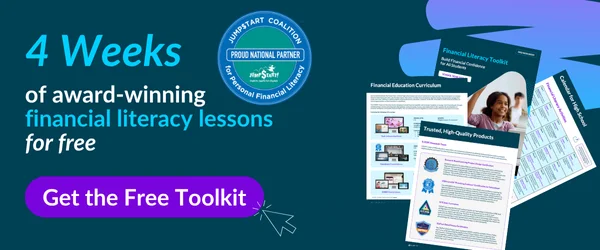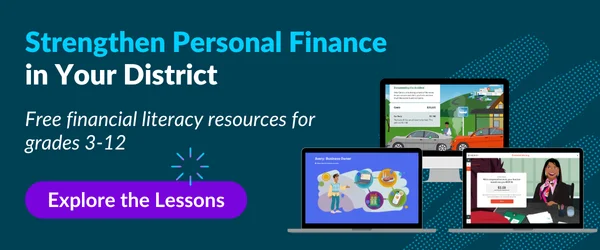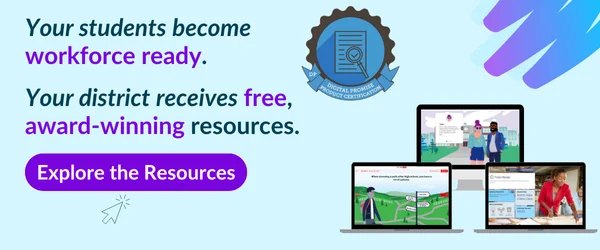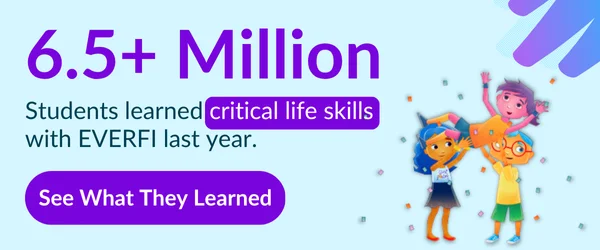- Blog
- How to Save Money as a Teenager: Budgeting Tips for Students
How to Save Money as a Teenager: Budgeting Tips for Students
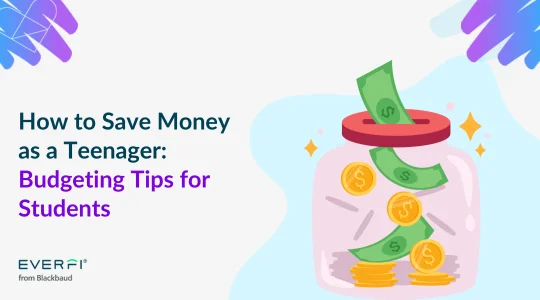
Author: EVERFI Content Team
Teen years are a dress rehearsal for independent, adult life. It is a time to learn and practice skills you will need for life on your own, but it comes with a safety net. Practice makes perfect! All you need to do is get money, save money, and spend wisely. Easy, right? Here are some tips to help.
Easy Steps to Start Saving Today
The first step in saving money is getting money. After all, you can’t save what you don’t have.
Tip #1: Earn so you can save.
To save money you need to get money from somewhere. So what can you do? Here are some ideas.
Gifts of Money from Family and Friends
When people aren’t sure what to gift, they often give gift cards, cash, or check. Instead of rushing out to spend it all the next day, consider saving it–or a part of it. Even gift cards can be saved and used together to make a big purchase.
Get a Job
Typical teen jobs are at established businesses like grocery stores, big box stores, retail shops, fast food, or coffee shops. Many hire extra help around holidays. Some even offer employee discounts, so if there’s a place you like to shop or eat, start looking there. You could also pet sit or babysit. If you don’t know anyone with pets or kids, you can create a profile on established websites like care.com.
Sell your creations
Use your talents and hobbies to make money. Many online platforms make selling creative products easy. Keep in mind, they all take a part of the selling price in some way–fees, percent of prices, etc. These platforms are businesses; those charges are how they make their money.
Some small businesses provide spaces for individuals to sell their products, so keep your eyes open and don’t be afraid to ask! For example, if you create pet-themed products, talk to local vets or locally owned pet supply store about selling some of your creations in their business.
Consign
Consigning is selling your stuff, usually clothes, in a physical store or online. The store gets a percent or sets a price, and you get money, store credit, or both. Do a quick online search for local consignment shops to find the stores in your area. Plato’s Closet is one national chain of physical clothing consignment shops, but they aren’t everywhere. If you can’t find a consignment shop near you, ThredUp is a well known online consignment platform with a good reputation.
Be careful if you decide to consign. If you only get paid in store credit, it only helps you pay for something in that store. It won’t help you save for a goal. Also, some stores pay by the item, others by the bag or the weight. However, if you have extra clothes, shoes, or accessories that you don’t want, why not turn them into savings?
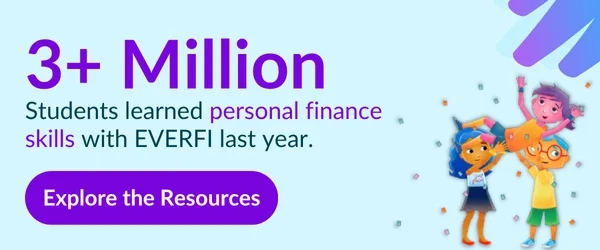
Tip #2: Ask Family or Other Adults in Your Life
The adults in your life (your family, coaches, mentors, etc.) want you to be a successful, independent adult. Make them partners in your savings journey. Try asking the adults closest to you to help you save by contributing to your savings in some way–but not just “free” money. Suggest ways you can earn money from them. For example, ask for payment when you do chores no one wants to do or as payment for improving your grades, practicing a sport or instrument more, or some other improvement. Let them know your savings progress. If you are close to a goal, they may even help you meet it.
Just remember, hold up your end of any deal you make, and be respectful if they say no. The adults around you usually have financial things going on that you don’t know about. They may want to help but might not be able to in the way you want, at the time you ask. This doesn’t mean they want to see you fail or don’t care about you. It just means they can’t. Be understanding, and try something else.
Now that you have money, or a plan to get money, what do you do with it? A piggy bank is one option, but that only works for cash. Here are some options that help you save your money and pay you to do it!
Tip #3: Open a Bank Account
In our electronic world, a bank account is increasingly necessary. Checking accounts (the kind you can spend from with a debit card) at traditional banks usually earn no interest, while credit unions and online-only banks often offer checking accounts with a low interest rate. Savings accounts tend to have higher interest rates, but aren’t usually connected to debit cards. Why do interest rates matter? Interest on a bank account is like free money. It’s money a financial institution pays you based on how much money you have in your accounts. The higher the interest rate, the more “free” money you get.
To open an account you usually have to be over 18 and have a parent co-owner on the account. This does not mean your parents can use your money; however, each financial institution is different. You also have to start with a certain amount of money in the account (“initial deposit”). Many financial institutions charge fees if you don’t keep a certain amount of money in your account (“minimum balance”).
Some banks offer special accounts for teens. For example, TD Bank is a regional bank with “perks” like no fees and no minimum balances on its accounts for kids, teens, and young adults up to age 23. Capital One is a national online bank with a fee-free, no-minimum MONEY Teen checking account that allows parents to deposit money.
Before you open a checking and/or savings account, shop around! Keep in mind that you don’t necessarily need to open an account where your parents’ bank. Find a financial institution that works best for you at this point in your life.
Tip #4: Invest in a Certificate of Deposit (CD)
If you have money that you plan on not spending for at least 6 months, putting it in a Certificate of Deposit (CDs) can be a safe investment. CDs allow you to put a set amount of money aside for a period of time while it collects interest. Interest rates for CDs tend to be higher than for bank accounts. Just make sure you don’t take money out early.
Once the time is up, you can even select an option to keep the interest in the CD account and just continue letting your money grow. Let’s say you start with $100 in a 6-month CD with a 4% APY and you just leave it there. After 4 years, you will have almost $120. That’s an extra $20 “free” money. Doesn’t sound like much at first, but remember, the more you save, the more “free” money you earn.
Great! You have money and a way to save money. But what if you need to spend? How do you spend wisely so you can also keep saving? Here are a few tips.
Tip #5: Make a Budget
Budgets are lists of how much money you have or will earn and how much you spend or plan to spend, usually for a month at a time. As with most things, there’s an app for that–lots of apps actually. Some are free when you open a bank account, but some cost money. If you think better with tech, find one that works for you. You can also write your budget on paper. This option can make the money you have and spend feel more real, which is a good thing. Hang your budget someplace you look daily to help keep yourself on track.
Budgets do involve math. You add the money you earn and subtract what you spend or plan to spend. Calculators make this fast and easy!
Tip #6: Stick to the Budget
Once you have a budget, you must stick to your budget. There’s not much point in coming up with a plan if you don’t follow it! Yes, sometimes things happen–you don’t earn what you predicted or you spend more than you planned. Sticking to a budget doesn’t mean you can’t make changes. It just means try your best, and make changes if needed.
Tip #7: Pay Cash Whenever Possible
Paying with cash can be a great way to save. It requires planning ahead. Take only the amount your budget allows you to spend, but make sure cash is accepted. Thinking before buying is a great way to not overspend. Additionally, any change you have left over can go right back into savings. Spending less than you budget then saving the “extra” is good financial habit.
You have money, you are saving it, and you are spending it wisely. Now keep it going and turn it into a habit for life! These tips can make that easier.
Tip #8: Set a Savings Goal
Staying motivated to save instead of spend can be hard, so give yourself a reason to save by setting smaller goals. The goal might be an item or experience or it might be a set dollar amount per month. Maybe you have a certain charity you want to support or a gift for a friend or family member you want to buy. Your goal could be saving a certain amount to give while also saving for your future. The key is finding what works for you. What will motivate you to save instead of spend?
Tip #9: Schedule Regular Savings Check-ins and Celebrations
You won’t know you are making progress towards your spending goal if you don’t check every so often. By scheduling regular financial check-in every couple weeks (or at least once a month), you can help yourself stay on your saving path. It will also create a habit that can be used later for independent adult responsibilities like paying bills.
Don’t just check in on your finances, celebrate your savings successes. If you saved a bit more than you planned one month, give yourself a sticker or budget a special treat (a small one) for yourself–whatever works to celebrate your progress and keep you motivated to continue.
Tip #10: Save with Friends
Friends frequently spend together, so why not save together? Plan time each month to budget together. Hold each other accountable (in a nice way). You don’t need to share financial details, or even budget specifics. You just need to support each other on your journey to building healthy saving and spending habits. You can also celebrate each other’s successes and encourage each other when challenges arise. Group motivation can be a powerful tool.
The Advantage of Saving Money Early
Why start now? First, good habits take time to develop. Starting to practice these habits now will make it easier to do them “for real” when you are on your own in the adult world. Second, saving for a goal and budgeting skills are tools for adult life, but they also come in handy before that. Teams, clubs, young entrepreneurs, etc. all need to be able to raise money, save for a goal, and spend wisely. Third, there will always be some “big ticket” item or experience you want that you can’t pay for without planning, saving, or both–car, house, college, vacation, medical emergency, etc. Learn and save now so that doing so in the future will be easier, and take advantage of the compound interest that comes along with it!
Eye-Opening Saving Stats
Recent studies show that teens typically save money, so you are not alone. Those who save the most tend to save with a goal in mind. Also, interest rates, although low, are on the rise. This means the amount of “free” money you will get from money in a bank account or CD is going up. Yay! More money! Let’s say you start with $100 and add another $25 each month to your savings for one year. At the current average savings account interest rate, you will end up with over $400 by the end of that year. Continue this habit for 10 years and you will have saved over $4000!
Learn to Save with EVERFI Financial Literacy Courses
You don’t have to start on the path to healthy financial habits on your own. Financial stuff can be confusing sometimes, even for adults. The EVERFI: Financial Literacy for High School course can teach you what you need to know for free! There are even free courses available to teach you about specific topics like paying for college or vocational schools, how to safely bank online, and even about investing or starting your own business! Use EVERFI courses as your financial GPS!

Jennifer Perrella has been educating kids and teens in Washington, DC and Tampa, FL for more than 20 years. She believes that it is critical to develop healthy financial habits early in life and that these habits can be learned in small ways–from putting pennies in a piggy bank as a child to running a charity fundraiser for as a teen, and everything in between.
Free for K-12 Educators
Thanks to partners, we provide our digital platform, training, and support at no cost.
See why 45k+ teachers were active on EVERFI digital resources last school year.
